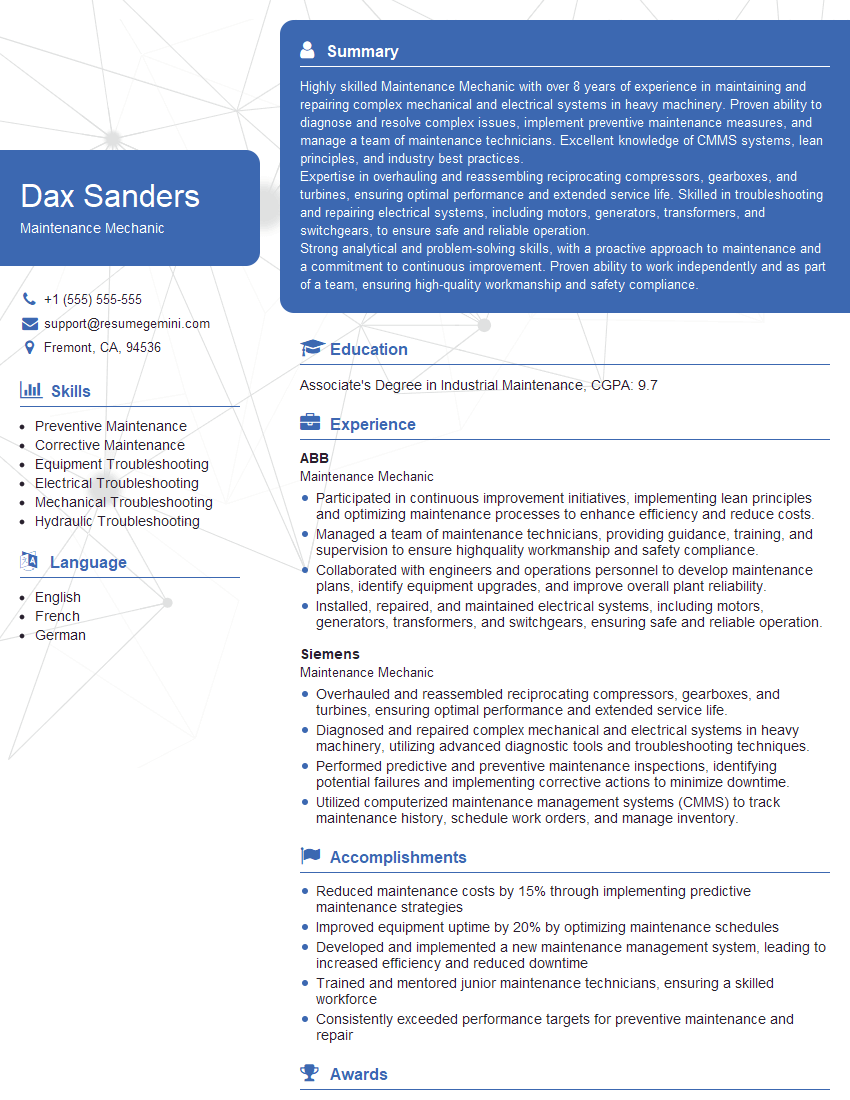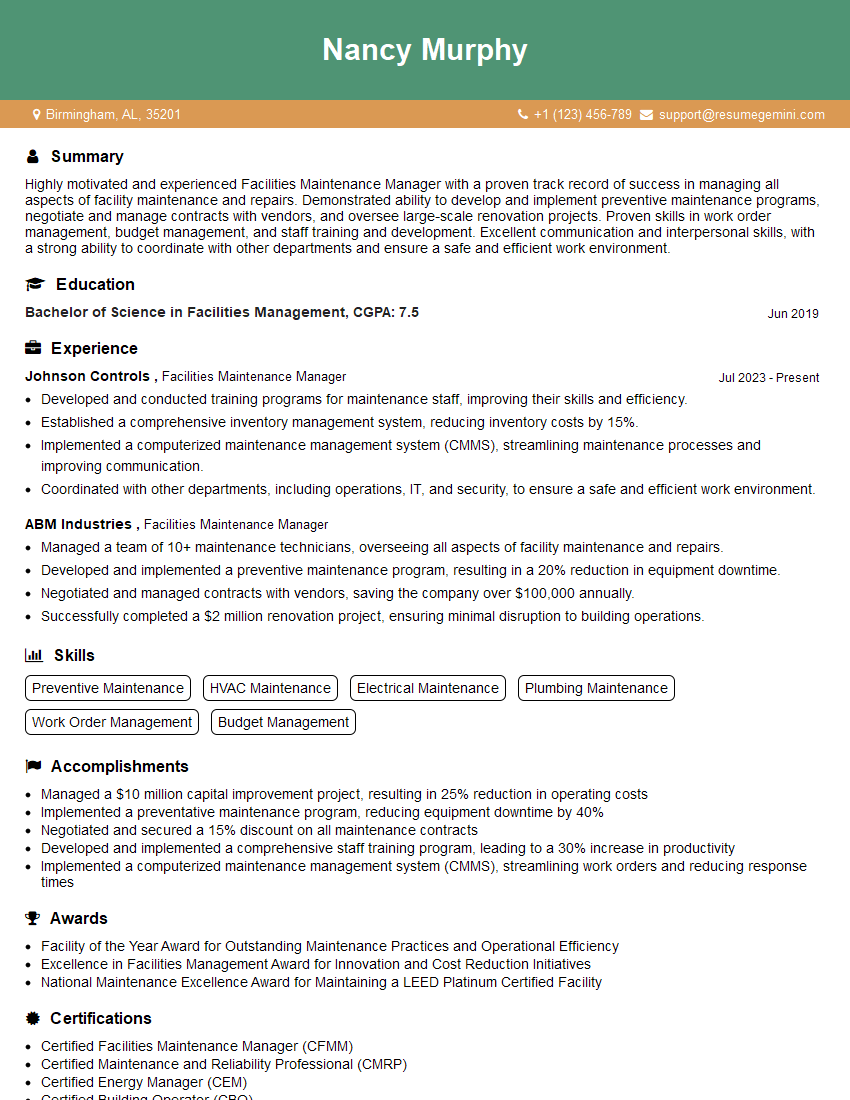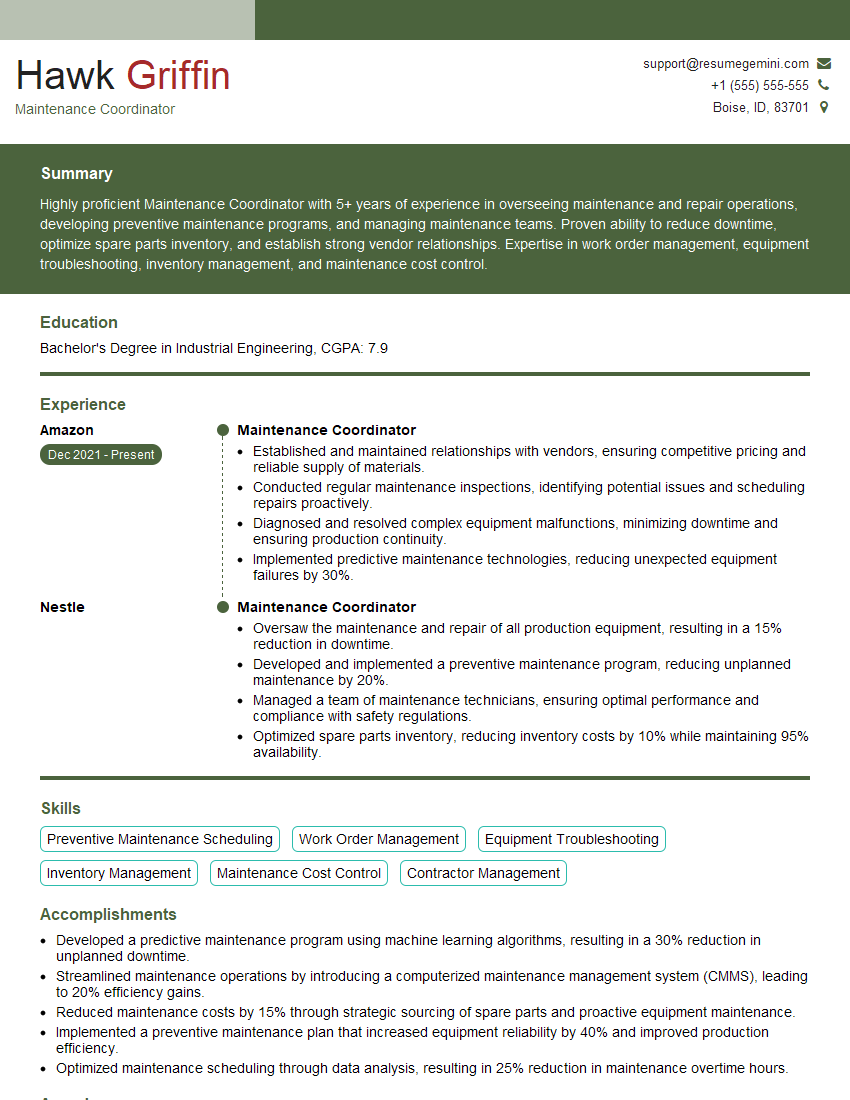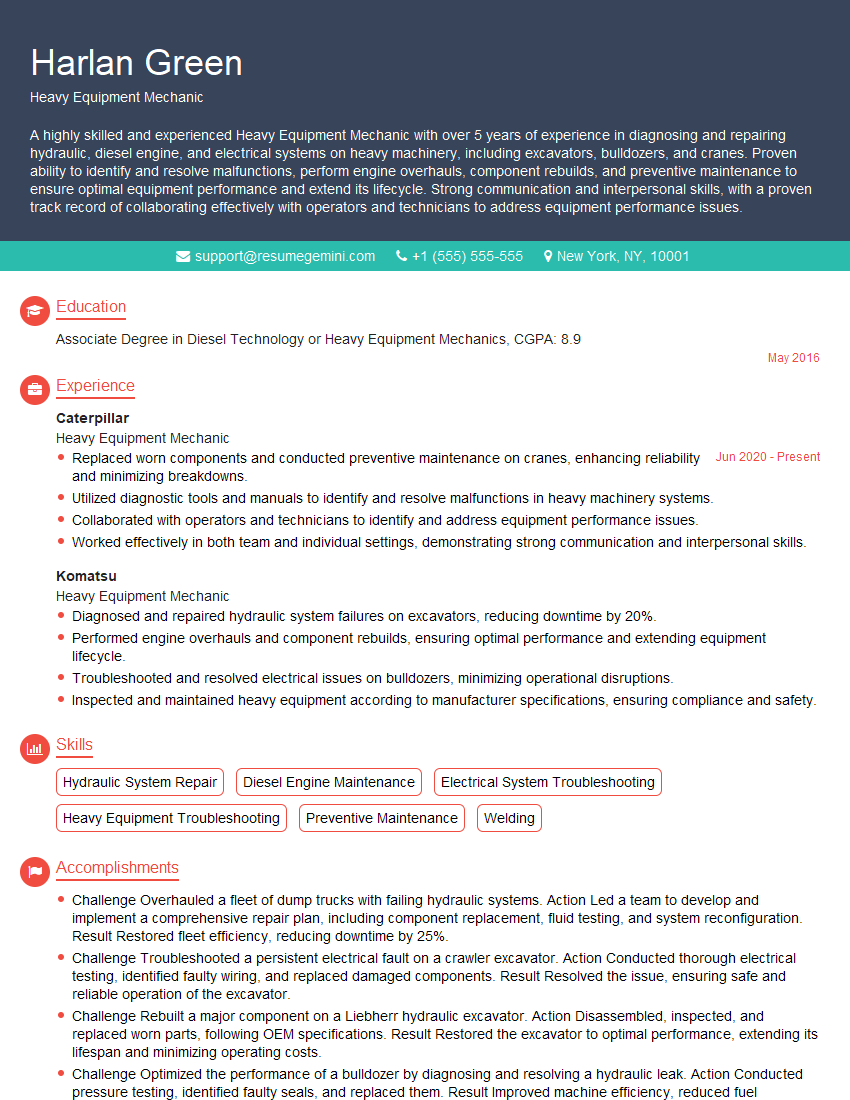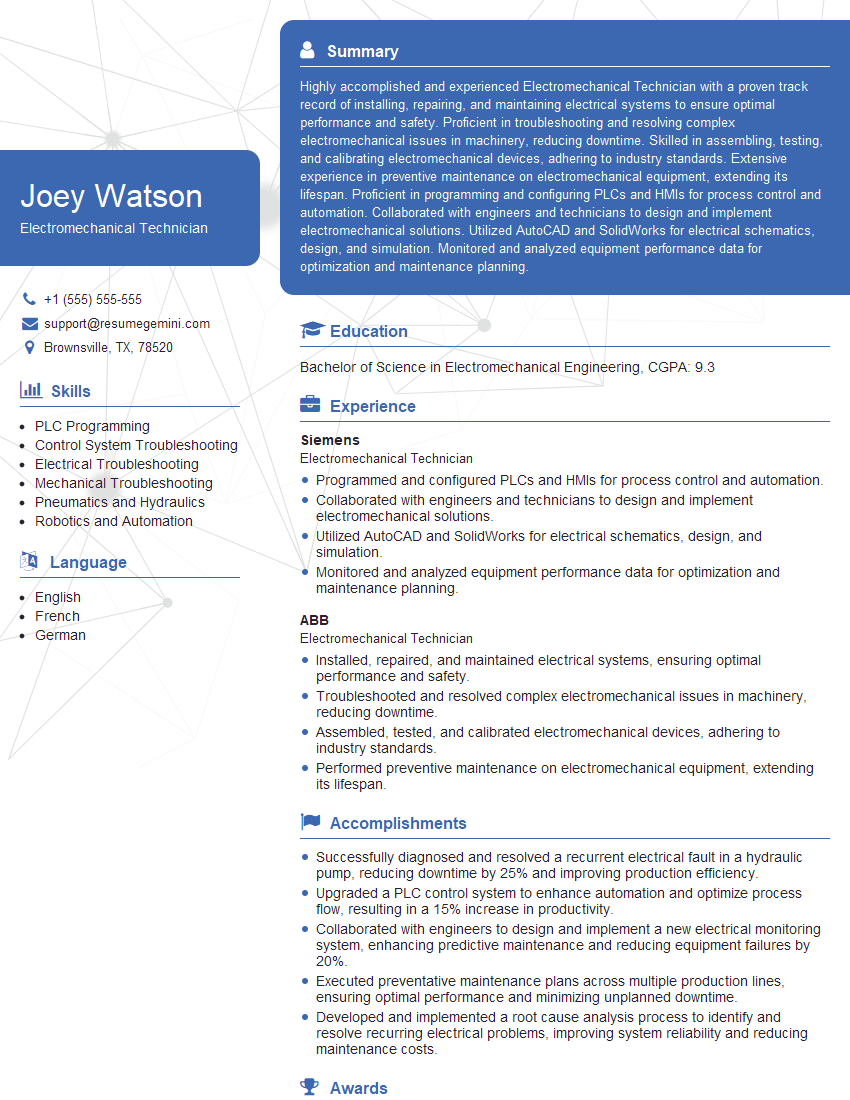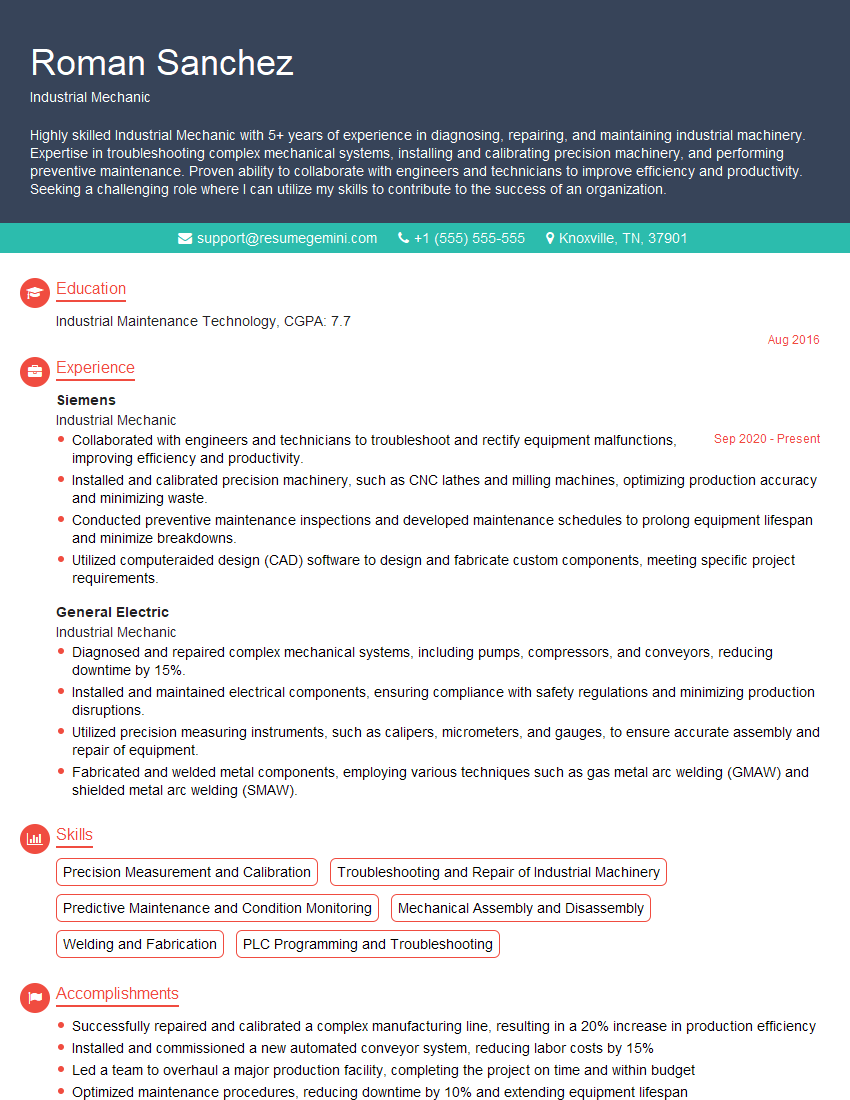Unlock your full potential by mastering the most common EquipmentMaintenance interview questions. This blog offers a deep dive into the critical topics, ensuring you’re not only prepared to answer but to excel. With these insights, you’ll approach your interview with clarity and confidence.
Questions Asked in EquipmentMaintenance Interview
Q 1. Describe your experience with preventive maintenance schedules.
Preventive maintenance schedules are the backbone of any reliable equipment operation. They involve systematically inspecting, cleaning, lubricating, and replacing parts of equipment before they fail. This proactive approach significantly reduces downtime, extends equipment lifespan, and ultimately lowers operational costs. I’ve developed and implemented numerous preventive maintenance schedules across diverse equipment types, from complex industrial machinery to smaller, more specialized tools.
For example, in my previous role at a manufacturing plant, I created a schedule for our automated packaging line. This involved a daily checklist for minor tasks like checking lubrication levels and inspecting for debris, a weekly inspection for more in-depth checks of belts and sensors, and a monthly, more involved lubrication and adjustment process. The schedule also incorporated quarterly inspections of the entire line, including electrical component checks and safety audits.
These schedules weren’t static; they were continuously refined based on data analysis. We tracked mean time between failures (MTBF) and mean time to repair (MTTR) to identify areas for improvement and adjust maintenance intervals as needed. A key aspect was using a CMMS system (more on that later) to manage these schedules and track their execution.
Q 2. Explain your troubleshooting methodology for malfunctioning equipment.
My troubleshooting methodology is systematic and follows a structured approach. It begins with a clear understanding of the problem. This involves gathering all relevant information, such as error messages, operational data, and any witness accounts. I then use a process of elimination, starting with the most likely causes based on my experience and knowledge of the equipment.
I often employ a five-why analysis to get to the root cause. For example, if a machine stops unexpectedly, I wouldn’t just restart it. I’d ask ‘Why did it stop?’ If the answer is ‘because a sensor failed,’ I’d ask ‘Why did the sensor fail?’ and continue until I identify the underlying issue – perhaps a loose connection, faulty wiring, or even a design flaw.
Visual inspection is crucial; looking for obvious signs of damage, leaks, or loose connections. I then move to more advanced diagnostics depending on the equipment, such as using multimeters to test electrical circuits, pressure gauges to check hydraulic systems, or vibration analyzers to detect mechanical issues.
Documentation is paramount throughout this process. Each step, finding, and decision is meticulously recorded to aid in future troubleshooting and prevent recurrence. Using this method allows for quicker resolution and facilitates effective preventative maintenance planning.
Q 3. What CMMS systems are you familiar with?
I’m proficient with several CMMS (Computerized Maintenance Management System) systems. My experience includes working with both IBM Maximo and SAP PM, as well as several cloud-based solutions like UpKeep and Fiix. Each system has its strengths and weaknesses, but they all provide the same core functionality: scheduling preventive maintenance, tracking work orders, managing inventory, and providing data analysis for improved maintenance strategies.
My experience goes beyond simply using these systems. I understand how to configure them effectively, tailor them to specific needs, and interpret their data to inform critical decisions. For instance, I’ve used Maximo to create customized dashboards that visually represented key performance indicators (KPIs) such as equipment uptime and maintenance costs, allowing for quick identification of trends and areas requiring immediate attention.
Q 4. How do you prioritize maintenance tasks in a high-pressure environment?
Prioritizing maintenance tasks in high-pressure situations requires a structured approach that balances urgency and long-term impact. I use a risk-based prioritization system. I start by categorizing tasks based on their potential consequences if not addressed promptly:
- Critical: Immediate risk of safety hazard, significant production downtime, or major financial loss.
- High: Potential for substantial disruption or significant costs if delayed.
- Medium: Minor inconvenience or moderate cost if delayed.
- Low: Minimal impact on operations or costs if delayed.
Within each category, tasks are prioritized based on their urgency. Critical tasks always take precedence, followed by high, medium, and low. This approach ensures that the most pressing issues are addressed immediately while still considering the longer-term maintenance needs. Visual management tools, like a Kanban board, can be very helpful in this process.
Furthermore, clear communication is vital. Regular briefings with the team and management are essential to ensure that everyone understands priorities and is aligned on the strategy.
Q 5. What are your skills in diagnosing electrical or mechanical failures?
My skills in diagnosing electrical and mechanical failures are extensive. I’m experienced in using various diagnostic tools and techniques for both disciplines.
Electrical failures: I use multimeters to check voltage, current, and resistance; oscilloscopes to analyze waveforms; and thermal imaging cameras to detect overheating components. I’m also proficient in reading electrical schematics and interpreting error codes. For instance, I once diagnosed a faulty motor controller on a conveyor belt by using an oscilloscope to identify intermittent voltage spikes that were damaging the device.
Mechanical failures: I utilize vibration analysis to detect imbalances, misalignments, and bearing problems. I’m adept at using precision measuring instruments such as calipers and micrometers to assess wear and tear. I can identify common mechanical issues such as bearing wear, gear damage, or hydraulic leaks through visual inspection and operational analysis. For instance, I diagnosed a failed pump by analyzing its vibration signature and identifying the characteristic frequencies associated with rotor imbalance.
My knowledge of both electrical and mechanical systems is crucial in many modern industrial settings, where mechanical and electrical systems often work in tandem.
Q 6. Describe your experience with root cause analysis.
Root cause analysis (RCA) is essential for preventing recurring equipment failures. It’s not just about fixing the immediate problem; it’s about identifying the underlying causes that led to the failure. I’m experienced in applying various RCA techniques, including the ‘5 Whys,’ fishbone diagrams (Ishikawa diagrams), and fault tree analysis.
For example, using the 5 Whys to investigate a recurring pump failure:
- Why did the pump fail? Because the bearings seized.
- Why did the bearings seize? Because of insufficient lubrication.
- Why was there insufficient lubrication? Because the lubrication system was clogged.
- Why was the lubrication system clogged? Because of a faulty filter.
- Why was the filter faulty? Because it wasn’t replaced according to the schedule.
This reveals the root cause: inadequate adherence to the preventive maintenance schedule. The solution isn’t just replacing the bearings; it’s improving the lubrication system maintenance process and ensuring the preventive maintenance schedule is strictly followed. This systematic approach leads to more effective and lasting solutions.
Q 7. How do you ensure equipment safety and compliance with regulations?
Equipment safety and regulatory compliance are paramount. I ensure compliance through a multi-faceted approach. This includes regular safety inspections, thorough documentation of all maintenance activities, and ensuring that all personnel involved are properly trained and follow safety protocols. I’m familiar with relevant safety regulations, such as OSHA (Occupational Safety and Health Administration) standards in the US or equivalent regulations in other regions.
Preventive maintenance itself is a critical aspect of ensuring equipment safety. By regularly inspecting and maintaining equipment, potential hazards are identified and addressed before they escalate into accidents. Regular lubrication, for example, prevents overheating and potential fires. Proper electrical grounding prevents electric shocks. And regular inspections of safety devices like emergency stops ensure they function correctly.
Beyond scheduled maintenance, I actively promote a safety-first culture. This involves regular training sessions, providing clear safety guidelines, and fostering open communication about safety concerns. A safe workplace is a productive workplace.
Q 8. Explain your experience with predictive maintenance techniques.
Predictive maintenance uses data and analytics to anticipate equipment failures before they occur, unlike reactive (fixing after failure) or preventive (scheduled maintenance) approaches. This significantly reduces downtime and maintenance costs. My experience involves utilizing various sensor technologies, such as vibration analysis, oil analysis, and thermal imaging, to collect data on equipment performance. For example, I worked on a project where we installed vibration sensors on critical pumps in a manufacturing plant. By analyzing the vibration data, we detected an impending bearing failure weeks in advance, allowing for a scheduled repair during a planned downtime, preventing a costly emergency shutdown. We used software that analyzed the frequency and amplitude of vibrations, flagging any deviations from established baselines. This allowed for proactive intervention, saving the company thousands of dollars in lost production and emergency repair costs.
Another example involved oil analysis. We regularly sampled the oil from large industrial engines, analyzing it for the presence of metal particles, water contamination, and changes in viscosity. These indicators can signal wear and tear, allowing for proactive maintenance like oil changes and component replacements before catastrophic failure. I’m proficient in interpreting this data and using it to optimize maintenance schedules and predict equipment lifespans. My expertise extends to utilizing software platforms for data analysis and predictive modeling, facilitating informed decision-making and enhancing the overall efficiency of maintenance operations.
Q 9. What is your experience with hydraulic and pneumatic systems?
I have extensive experience working with both hydraulic and pneumatic systems. Hydraulic systems utilize liquids under pressure to transmit power, while pneumatic systems use compressed air. My experience encompasses troubleshooting, repair, and maintenance of a wide range of components within these systems, including pumps, valves, cylinders, actuators, and compressors. For instance, I’ve successfully diagnosed and repaired leaks in hydraulic systems using pressure testing and dye penetrant inspection. In one case, I traced a leak in a high-pressure hydraulic line to a faulty fitting, preventing a potentially dangerous and costly system failure. I am familiar with various types of hydraulic fluids and their properties and understand the importance of proper fluid selection and maintenance for optimal system performance. In pneumatic systems, I have experience troubleshooting air leaks using specialized leak detection equipment and replacing worn or damaged components, such as air filters and regulators. I understand the principles of air compression and the importance of proper air filtration to prevent contamination and system damage.
Q 10. How do you manage maintenance budgets and resources effectively?
Effective maintenance budget and resource management requires a strategic and data-driven approach. It begins with accurate forecasting of maintenance needs based on historical data, equipment condition assessments, and predictive maintenance analyses. This allows for the creation of a realistic budget that includes both planned and unplanned maintenance expenses. I utilize various budgeting techniques, including zero-based budgeting and activity-based costing, to allocate resources effectively. Resource management involves optimizing the allocation of personnel, tools, and parts. I use computerized maintenance management systems (CMMS) to schedule maintenance tasks, track inventory, and manage work orders efficiently. For instance, I developed a system using a CMMS to prioritize maintenance tasks based on their criticality and cost-effectiveness. This resulted in a significant reduction in downtime and improved resource allocation.
Furthermore, I actively seek cost-effective solutions without compromising quality. This can include negotiating better prices with suppliers, implementing preventative maintenance strategies to reduce the frequency of costly repairs, and investing in efficient tools and technologies. Regular monitoring and analysis of maintenance expenses allows for identifying areas for improvement and making data-driven adjustments to the budget and resource allocation strategies. Continuous improvement is essential to optimize resource utilization and ensure the effective and efficient operation of the maintenance department.
Q 11. Describe your experience with welding or fabrication.
My welding and fabrication experience encompasses both MIG (Metal Inert Gas) and TIG (Tungsten Inert Gas) welding techniques. I’m proficient in various welding processes, including shielded metal arc welding (SMAW) and gas metal arc welding (GMAW). I’ve used these skills extensively for repair and fabrication of various metal components in equipment maintenance. For example, I’ve repaired damaged structural steel components in industrial machinery using MIG welding, ensuring structural integrity and safety. I also have experience in fabricating custom parts from blueprints and sketches, often creating solutions for unique maintenance challenges. This includes designing and constructing jigs and fixtures to support repair activities. I also possess a strong understanding of material selection and the implications of different welding processes on material properties. Safety is always paramount in my welding operations, and I meticulously follow all safety protocols, including proper ventilation, eye protection, and fire prevention measures. My fabrication skills are often utilized to create custom tools or adapt existing tools to solve specific maintenance problems, optimizing efficiency and effectiveness.
Q 12. How do you handle emergency repairs and equipment breakdowns?
Handling equipment breakdowns requires a rapid and systematic response. My approach involves immediately assessing the situation to ensure safety, then prioritizing the repair based on its criticality to operations. A swift diagnosis is key, which often involves carefully examining the equipment, gathering information from operators, and utilizing troubleshooting techniques specific to the equipment type. I use a structured troubleshooting approach—a systematic process of elimination—to identify the root cause of the failure. I frequently utilize diagnostic tools like multimeters, oscilloscopes, and pressure gauges to assist in this process. Once the root cause is identified, the repair is prioritized. Emergency repairs focus on restoring functionality as quickly and safely as possible; complete repairs might be deferred until a scheduled downtime. Communication is critical. I keep stakeholders informed throughout the entire process, providing regular updates on progress and expected downtime.
For example, during an unexpected power surge, a critical conveyor belt system malfunctioned. I quickly assessed the situation, isolating the affected section to ensure safety. Through systematic troubleshooting, I identified a blown fuse in the control panel. Replacing the fuse restored the system quickly, minimizing production downtime. After the immediate repair, I investigated the root cause of the surge to prevent future occurrences. This included collaborating with the electrical team to implement surge protection measures. A thorough post-incident analysis helps improve future responses and preventive measures.
Q 13. What safety procedures do you follow when performing maintenance?
Safety is my top priority. I strictly adhere to all relevant safety regulations and company policies. Before undertaking any maintenance activity, I perform a thorough risk assessment, identifying potential hazards and implementing appropriate control measures. This includes using proper personal protective equipment (PPE), such as safety glasses, gloves, hearing protection, and steel-toed boots, based on the specific task. Lockout/Tagout (LOTO) procedures are strictly followed to prevent accidental equipment energization during maintenance, ensuring the safety of myself and others. I am also trained in confined space entry procedures and follow strict protocols when working in confined spaces. Regular safety training and refresher courses ensure I stay updated on the latest safety regulations and best practices. I believe in a proactive safety culture, reporting any near misses or unsafe conditions immediately to prevent accidents. My commitment to safety ensures a safe work environment for myself and my colleagues, contributing to a productive and incident-free maintenance program.
Q 14. Explain your understanding of lubrication and its importance.
Lubrication is crucial for equipment reliability and longevity. It reduces friction between moving parts, minimizing wear and tear, heat generation, and potential damage. Proper lubrication extends equipment lifespan, reduces maintenance costs, and improves overall efficiency. Different types of lubricants are suitable for various applications and operating conditions. The selection of the correct lubricant is critical, considering factors like viscosity, temperature range, and the type of equipment. I am experienced in selecting and applying various lubricants, including greases, oils, and specialized lubrication products. I also understand the importance of proper lubrication techniques, including the use of appropriate tools and procedures to ensure effective lubrication and minimize contamination.
For example, inaccurate lubrication of a high-speed bearing can lead to premature failure, resulting in costly downtime and repairs. I’ve personally witnessed cases where improper lubrication caused significant damage, highlighting the importance of following manufacturer’s recommendations and using appropriate lubrication schedules and techniques. Regular lubrication checks and monitoring are part of my preventive maintenance strategy, allowing for early detection of potential lubrication problems and reducing the risk of equipment failure. I use lubrication charts and maintenance schedules provided by the equipment manufacturers as guidelines, and I adapt these to specific conditions based on my experience and observations.
Q 15. How familiar are you with different types of bearings and their applications?
My familiarity with bearings extends across various types, encompassing their design, functionality, and applications within diverse machinery. Understanding bearings is crucial for effective equipment maintenance, as they’re fundamental components in rotating equipment.
- Ball Bearings: These are ubiquitous, using rolling elements (balls) to minimize friction between rotating and stationary surfaces. They are ideal for high-speed applications, but have limitations under heavy radial loads.
- Roller Bearings: Utilizing cylindrical or tapered rollers, these bearings handle heavier radial loads than ball bearings, making them suitable for applications like conveyor systems or large motors. Tapered roller bearings are particularly adept at managing both radial and axial loads.
- Thrust Bearings: Designed to withstand primarily axial loads (forces along the shaft axis), these are critical in applications like propeller shafts or vertical pumps. They often utilize a combination of balls or rollers.
- Sleeve Bearings (Journal Bearings): These bearings utilize a fluid film (oil or grease) to separate rotating surfaces. They are quieter than rolling-element bearings but have lower load-carrying capacity and require precise lubrication.
For example, in maintaining a large industrial fan, I’d need to understand the specific bearing type used (likely roller bearings due to the high radial loads) to select appropriate lubricants, assess wear patterns, and schedule preventative maintenance effectively. Choosing the wrong lubricant could lead to premature bearing failure.
Career Expert Tips:
- Ace those interviews! Prepare effectively by reviewing the Top 50 Most Common Interview Questions on ResumeGemini.
- Navigate your job search with confidence! Explore a wide range of Career Tips on ResumeGemini. Learn about common challenges and recommendations to overcome them.
- Craft the perfect resume! Master the Art of Resume Writing with ResumeGemini’s guide. Showcase your unique qualifications and achievements effectively.
- Don’t miss out on holiday savings! Build your dream resume with ResumeGemini’s ATS optimized templates.
Q 16. Describe your experience with rotating equipment maintenance.
My experience with rotating equipment maintenance spans over [Number] years, encompassing a wide array of machinery including pumps, compressors, motors, turbines, and generators. I’ve been involved in all aspects of maintenance, from routine inspections and lubrication to complex overhauls and troubleshooting.
For instance, I recently led a team in the overhaul of a large centrifugal pump experiencing reduced efficiency. Through a meticulous process involving vibration analysis, oil sampling, and visual inspection, we identified worn bearings and impeller imbalance as the root causes. We replaced the faulty bearings, balanced the impeller, and performed a complete lubrication system flush, restoring the pump to its original performance levels. This project involved working closely with engineers, technicians, and procurement to ensure parts availability and adhere to safety protocols.
This kind of work requires a comprehensive understanding of mechanical principles, diagnostic techniques, and safety procedures. I also have experience in predictive maintenance techniques, using tools like vibration analysis and infrared thermography to identify potential issues before they escalate into major failures.
Q 17. How do you document maintenance activities and track results?
Detailed documentation and meticulous result tracking are paramount in equipment maintenance. We utilize a Computerized Maintenance Management System (CMMS) to record all activities. This system allows for centralized data storage, improved communication, and efficient reporting.
- Work Orders: Each maintenance activity is initiated with a work order detailing the task, assigned personnel, required materials, and scheduled completion time.
- Inspection Reports: Comprehensive inspection reports, complete with photos and videos, document the condition of equipment, highlighting potential issues.
- Maintenance Logs: These logs provide a chronological record of all maintenance performed, including date, time, performed tasks, and personnel involved.
- Performance Metrics: The CMMS facilitates tracking key performance indicators (KPIs), such as Mean Time Between Failures (MTBF) and Mean Time To Repair (MTTR), allowing us to assess maintenance program effectiveness and identify areas for improvement.
For example, if a pump experiences recurring failures, the CMMS data allows us to analyze the frequency, type of failure, and maintenance history, which might uncover patterns revealing underlying problems with lubrication, alignment, or operating conditions. This systematic approach greatly improves the effectiveness of our preventative maintenance and minimizes downtime.
Q 18. What is your experience with interpreting technical manuals and drawings?
Interpreting technical manuals and drawings is a fundamental aspect of my work. My proficiency allows me to understand equipment specifications, assembly procedures, wiring diagrams, and troubleshooting guides. I am adept at using both physical and digital versions of these documents.
A recent example involved troubleshooting a malfunctioning PLC (Programmable Logic Controller) in a packaging line. By carefully studying the PLC ladder logic diagram and the equipment’s electrical schematics, I was able to trace the fault to a faulty sensor and subsequently replace it, restoring the line to full operation. My familiarity with various CAD software and technical documentation formats further enhances my ability to decipher these documents.
This skill ensures accuracy in maintenance tasks and reduces the likelihood of errors. I also possess the ability to interpret manufacturer’s recommendations and apply them correctly to ensure optimal equipment performance.
Q 19. How do you work effectively within a team to perform maintenance tasks?
Effective teamwork is indispensable in maintenance. I believe in fostering a collaborative environment based on clear communication, mutual respect, and shared responsibility. I actively participate in pre-job briefings, ensuring everyone is aware of the task, safety protocols, and their individual roles.
During maintenance, I actively communicate progress, any challenges encountered, and potential solutions. I also encourage team members to voice their opinions and concerns. This fosters a safety-conscious environment and prevents misunderstandings. I am always willing to assist colleagues, share my expertise, and learn from their experience.
For instance, during a recent shutdown, we were facing a tight deadline. Through efficient task delegation and clear communication, we were able to complete the scheduled maintenance ahead of schedule while adhering to all safety regulations. This team collaboration demonstrates my ability to lead and work effectively within a group setting, leading to improved efficiency and overall safety.
Q 20. What are your skills in using diagnostic tools and equipment?
My proficiency encompasses a wide range of diagnostic tools and equipment, including:
- Vibration Analyzers: These are critical for detecting imbalances, misalignments, and bearing defects in rotating equipment. I’m experienced in interpreting vibration spectra to diagnose root causes.
- Infrared Thermography Cameras: I utilize these to detect overheating components, which can indicate impending failures in electrical systems, bearings, and other equipment.
- Ultrasonic Leak Detectors: I employ these tools to locate air or gas leaks in pressurized systems, preventing loss of efficiency and safety hazards.
- Motor Testers: I use these for comprehensive motor diagnostics, measuring insulation resistance, winding integrity, and other parameters to identify potential problems.
- Digital Multimeters: These are invaluable for general electrical diagnostics, measuring voltage, current, and resistance.
For example, during a recent motor diagnostic, a combination of vibration analysis and infrared thermography helped pinpoint a bearing failure just before a catastrophic breakdown occurred, avoiding costly downtime and potential safety hazards. The precise identification of the problem allowed us to schedule a timely and effective repair, rather than replacing the entire motor unnecessarily.
Q 21. Describe your experience with calibration and verification procedures.
Calibration and verification procedures are essential for ensuring the accuracy and reliability of measurement instruments. I am experienced in performing calibration and verification activities according to established standards and procedures.
This typically includes using calibrated reference standards and following documented procedures. For example, I’ve calibrated pressure gauges, temperature sensors, flow meters, and vibration transducers, using traceable calibration certificates to validate their accuracy. This is crucial for ensuring the data we collect during diagnostics is reliable, leading to accurate diagnosis and preventing errors during maintenance. I maintain comprehensive records of all calibration and verification activities, demonstrating our commitment to compliance with industry standards and best practices.
Regular calibration of our equipment also ensures compliance with safety regulations and prevents incorrect measurements which could lead to faulty maintenance decisions and potentially dangerous situations. The process ensures our measurements are consistently accurate and reliable.
Q 22. How do you stay current with the latest maintenance technologies and best practices?
Staying current in the dynamic field of equipment maintenance requires a multi-pronged approach. It’s not enough to rely solely on past experience; continuous learning is crucial.
- Professional Organizations: I actively participate in organizations like the Society for Maintenance & Reliability Professionals (SMRP), attending webinars, conferences, and workshops to learn about new technologies and best practices. These events often feature case studies and real-world examples, making the learning highly relevant.
- Industry Publications and Journals: I regularly read industry-leading publications like Maintenance Technology and Uptime Magazine. These resources provide insights into emerging trends, innovative solutions, and best practices from leading experts in the field.
- Online Courses and Certifications: I leverage online platforms like Coursera and LinkedIn Learning to enhance my skills in specific areas, such as predictive maintenance using AI or advanced lubrication techniques. Certifications validate my expertise and demonstrate a commitment to continuous improvement.
- Manufacturer Training: Directly engaging with equipment manufacturers through their training programs is invaluable. This provides hands-on experience with the latest technologies and ensures I’m familiar with the manufacturer’s recommended maintenance procedures.
- Networking: Attending industry events and connecting with other professionals through online forums allows me to exchange ideas, discuss challenges, and learn from others’ experiences. This collaborative approach is extremely valuable.
This combination of formal education, professional networking, and self-directed learning ensures I remain at the forefront of equipment maintenance advancements.
Q 23. Explain your experience with inventory management of maintenance parts.
Effective inventory management of maintenance parts is paramount for minimizing downtime and optimizing maintenance costs. My experience encompasses both manual and computerized systems.
In previous roles, I’ve used Computerized Maintenance Management Systems (CMMS) such as IBM Maximo and SAP PM to track parts inventory. These systems allow for accurate tracking of part numbers, quantities on hand, minimum stock levels, and reorder points. They also integrate with procurement systems to streamline the ordering process. For example, when the stock level of a critical bearing falls below the defined minimum, the CMMS automatically generates a purchase requisition, triggering the procurement process.
Beyond the CMMS, I understand the importance of physical inventory checks, regularly verifying stock levels against the system records. This helps to identify discrepancies, potential issues with accuracy, or even instances of theft or damage. I’ve also implemented a system of visual cues – like color-coded labels indicating criticality or nearing-expiry dates – to aid in efficient warehouse management.
A key aspect of my approach is ABC analysis, categorizing parts based on their usage and criticality (A: high value/high usage, B: medium value/usage, C: low value/usage). This allows for focused attention on managing critical parts, while implementing more streamlined processes for less critical items.
Q 24. How do you ensure the accuracy and reliability of maintenance records?
Accurate and reliable maintenance records are the backbone of any effective maintenance program. They provide crucial insights for preventative maintenance scheduling, troubleshooting, and cost analysis. Ensuring their accuracy and reliability requires a structured approach.
- Standardized Procedures: Implementing standardized forms and checklists ensures data consistency. This reduces errors and simplifies data entry.
- Digitalization: Utilizing CMMS software significantly reduces human error compared to manual record-keeping. These systems offer features for automated data entry, eliminating manual transcription and improving data accuracy.
- Regular Audits: Periodic audits of maintenance records are crucial to identify discrepancies and areas for improvement. This includes comparing CMMS data with physical inspections and verifying the accuracy of recorded work performed.
- Training and Clear Guidelines: Maintenance personnel must receive comprehensive training on the proper use of data entry systems and record-keeping procedures. Clear instructions on data formats, codes, and reporting protocols are essential.
- Data Validation: Implementing data validation rules within the CMMS (for example, ensuring only valid part numbers are entered) helps prevent errors during data entry.
By combining standardized procedures with robust digital tools and regular audits, I’ve ensured that maintenance records accurately reflect the status of equipment and provide a reliable basis for decision-making.
Q 25. Describe a time you had to solve a complex maintenance problem.
During my time at a large manufacturing plant, a critical production line experienced unexpected shutdowns due to frequent failures of a high-speed conveyor system. Initial troubleshooting by the maintenance team focused on individual components, but the problem persisted. This was causing significant production delays and impacting overall output.
I approached the problem by taking a more systematic approach. I started by analyzing the maintenance logs, looking for patterns in the failures. I noticed that the failures often occurred after periods of high throughput. This suggested the problem wasn’t with individual components, but rather with the overall system’s capacity under stress. I then conducted a thorough inspection of the conveyor’s mechanical alignment, motor performance, and drive system. This investigation revealed that the conveyor’s drive motor was overloading during peak production periods, leading to premature failures.
My solution involved a two-pronged approach: First, we upgraded the motor to a higher-capacity model, addressing the overloading issue. Second, we implemented a preventative maintenance schedule to regularly inspect and lubricate the entire conveyor system, improving the overall efficiency and minimizing friction. This combination of preventative and corrective maintenance resolved the issue and eliminated the recurring breakdowns.
Q 26. How do you handle conflicting priorities in maintenance scheduling?
Conflicting priorities in maintenance scheduling are a common challenge. Effective management requires a systematic approach prioritizing tasks based on their impact on overall operations and potential risks.
I use a prioritization matrix that considers several factors:
- Criticality: How essential is the equipment to production? A breakdown of a critical piece of equipment would have a significantly greater impact than a non-critical one.
- Urgency: How imminent is the risk of failure? A machine with an impending catastrophic failure requires immediate attention.
- Cost of Failure: What are the financial consequences of equipment failure (lost production, repair costs, safety risks)?
- Preventative vs. Corrective: Preventative maintenance, although sometimes less urgent, is crucial for long-term reliability. A balance is needed.
I often use a weighted scoring system assigning scores to each factor. Tasks with higher combined scores are prioritized. This structured approach, combined with open communication with production teams, ensures that maintenance efforts are aligned with overall business objectives. When truly unavoidable conflicts arise, I escalate to management for decision-making, ensuring transparency and collaborative problem-solving.
Q 27. What is your understanding of Total Productive Maintenance (TPM)?
Total Productive Maintenance (TPM) is a holistic approach to equipment maintenance that involves all employees, not just the maintenance department, in improving equipment reliability and overall productivity. It’s a proactive strategy focusing on preventing equipment failure rather than simply reacting to breakdowns.
Key elements of TPM include:
- Autonomous Maintenance: Empowering operators to perform basic maintenance tasks, like cleaning and lubrication, increases their ownership and reduces the burden on the maintenance team.
- Planned Maintenance: Developing and rigorously following preventative maintenance schedules ensures equipment is maintained at optimal performance levels.
- Early Failure Detection: Implementing techniques such as vibration analysis, thermal imaging, and oil analysis allows for early identification of potential problems before they become major failures.
- Continuous Improvement: TPM emphasizes a culture of continuous improvement, with regular meetings and problem-solving sessions to identify and address equipment-related issues.
- Training and Education: Extensive training for all employees on maintenance best practices, safety procedures, and equipment operation is crucial.
Successfully implementing TPM requires a strong commitment from all levels of an organization, fostering a collaborative culture focused on maximizing equipment effectiveness and minimizing downtime.
Q 28. Describe your experience with implementing maintenance improvements.
In a previous role, we implemented a predictive maintenance program to reduce unexpected downtime on a critical bottling line. The line frequently experienced unscheduled stoppages due to pump failures, resulting in significant production losses.
Our implementation involved several steps:
- Data Acquisition: We installed vibration sensors and temperature sensors on the pumps to collect real-time data. This data was transmitted to a central CMMS system.
- Data Analysis: Using predictive analytics software, we analyzed the sensor data to identify patterns and predict potential failures before they occurred.
- Maintenance Optimization: Based on the predictive analysis, we adjusted the preventative maintenance schedule, targeting maintenance activities to address potential failures before they impacted production.
- Training: We trained maintenance personnel on how to interpret the data and respond appropriately to potential alerts.
The results were significant. After implementing the predictive maintenance program, we saw a 30% reduction in unscheduled downtime on the bottling line. This translated to substantial cost savings and improved production efficiency. The success of this project demonstrated the value of integrating advanced technologies into maintenance strategies for optimizing equipment performance and minimizing disruptions.
Key Topics to Learn for Equipment Maintenance Interview
- Preventive Maintenance (PM): Understanding PM schedules, techniques, and their impact on equipment lifespan and operational efficiency. Practical application: Developing and implementing a PM plan for a specific piece of equipment.
- Predictive Maintenance (PdM): Learning about various PdM technologies (vibration analysis, oil analysis, thermography) and how they are used to anticipate equipment failures. Practical application: Interpreting PdM data to prioritize maintenance tasks and prevent unexpected downtime.
- Corrective Maintenance: Troubleshooting malfunctioning equipment, diagnosing faults, and performing repairs efficiently and safely. Practical application: Describing your approach to diagnosing a common equipment problem and outlining the repair process.
- Safety Procedures and Regulations: Demonstrating knowledge of relevant safety standards (OSHA, etc.) and best practices for working with machinery and hazardous materials. Practical application: Explaining your experience with lockout/tagout procedures or other safety protocols.
- Maintenance Management Systems (CMMS): Familiarity with CMMS software for tracking maintenance activities, managing inventory, and generating reports. Practical application: Discussing your experience using a CMMS to optimize maintenance scheduling and resource allocation.
- Root Cause Analysis (RCA): Understanding techniques like the 5 Whys or fishbone diagrams to identify the underlying causes of equipment failures and prevent recurrence. Practical application: Explaining how you’d use RCA to address a recurring problem with a specific piece of equipment.
- Equipment Specific Knowledge: Thorough understanding of the specific types of equipment you’ll be maintaining (e.g., hydraulic systems, electrical systems, engines). Practical application: Detailing your experience working with particular equipment types and your proficiency in their maintenance.
Next Steps
Mastering Equipment Maintenance is crucial for career advancement, opening doors to higher-paying roles with increased responsibility and opportunities for professional growth. A strong, ATS-friendly resume is your key to unlocking these opportunities. Make sure your resume clearly highlights your skills and experience in the areas discussed above. To create a truly impactful resume that catches the eye of recruiters, leverage the power of ResumeGemini. ResumeGemini provides a user-friendly platform to build professional, ATS-optimized resumes. Examples of resumes tailored to Equipment Maintenance professionals are available to help you get started.
Explore more articles
Users Rating of Our Blogs
Share Your Experience
We value your feedback! Please rate our content and share your thoughts (optional).
What Readers Say About Our Blog
Hi, I represent an SEO company that specialises in getting you AI citations and higher rankings on Google. I’d like to offer you a 100% free SEO audit for your website. Would you be interested?
good






